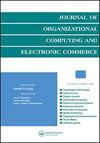工作场所的聊天机器人:一项应用于共享办公空间的技术接受研究
IF 1.9
4区 管理学
Q3 COMPUTER SCIENCE, INFORMATION SYSTEMS
Journal of Organizational Computing and Electronic Commerce
Pub Date : 2022-10-02
DOI:10.1080/10919392.2023.2215666
引用次数: 0
摘要
使用和满足方法用于检查共享工作空间中的聊天机器人接受度,确定同事如何看待该技术并可能使用它来促进他们的任务。为此,本文探讨了影响技术接受度的潜在因素,并采用偏最小二乘结构方程建模和必要条件分析定量结合的方法,以101名德国同事为样本,对框架进行了确认。工具满足和非工具满足以及社会规范以充分条件和必要条件的形式影响聊天机器人的接受,并且在充足性方面,社会规范似乎比享乐因素具有更实质性的影响。然而,社会规范并不是必要条件。一项版主分析显示,隐私问题、年龄和性别不会影响个人使用聊天机器人的意愿。因此,联合办公空间提供商可以通过建立一个标准的聊天机器人解决方案来利用社会规范,所选择的解决方案除了有用之外,还需要满足享乐期望。软件供应商也可以将专用接口集成到强大的解决方案中,如ChatGPT。本文章由计算机程序翻译,如有差异,请以英文原文为准。
CHATBOTS IN THE WORKPLACE: A TECHNOLOGY ACCEPTANCE STUDY APPLYING USES AND GRATIFICATIONS IN COWORKING SPACES
ABSTRACT The uses and gratifications approach is used to examine chatbot acceptance in coworking spaces, identifying how coworkers perceive the technology and may use it to facilitate their tasks. To do so, potential influence factors shaping technology acceptance are explored, and a sample of 101 German coworkers is employed to confirm the framework drawing on a quantitative combination of partial least squares structural equation modeling and necessary condition analysis. Instrumental and non-instrumental gratifications, as well as social norm, influence chatbot acceptance in the form of sufficient and necessary conditions, and social norm appears to have a more substantial impact than hedonic factors in terms of sufficiency. However, social norm is not a necessary condition. A moderator analysis reveals that privacy concerns, age and gender do not affect individuals’ intention to use a chatbot. Coworking space providers thus benefit from establishing a standard chatbot solution to leverage social norm, and the chosen solution needs to fulfill hedonic expectations in addition to being useful. Software vendors may also integrate dedicated interfaces to powerful solutions such as ChatGPT.
求助全文
通过发布文献求助,成功后即可免费获取论文全文。
去求助
来源期刊

Journal of Organizational Computing and Electronic Commerce
工程技术-计算机:跨学科应用
CiteScore
5.80
自引率
17.20%
发文量
7
审稿时长
>12 weeks
期刊介绍:
The aim of the Journal of Organizational Computing and Electronic Commerce (JOCEC) is to publish quality, fresh, and innovative work that will make a difference for future research and practice rather than focusing on well-established research areas.
JOCEC publishes original research that explores the relationships between computer/communication technology and the design, operations, and performance of organizations. This includes implications of the technologies for organizational structure and dynamics, technological advances to keep pace with changes of organizations and their environments, emerging technological possibilities for improving organizational performance, and the many facets of electronic business.
Theoretical, experimental, survey, and design science research are all welcome and might look at:
• E-commerce
• Collaborative commerce
• Interorganizational systems
• Enterprise systems
• Supply chain technologies
• Computer-supported cooperative work
• Computer-aided coordination
• Economics of organizational computing
• Technologies for organizational learning
• Behavioral aspects of organizational computing.
 求助内容:
求助内容: 应助结果提醒方式:
应助结果提醒方式:


